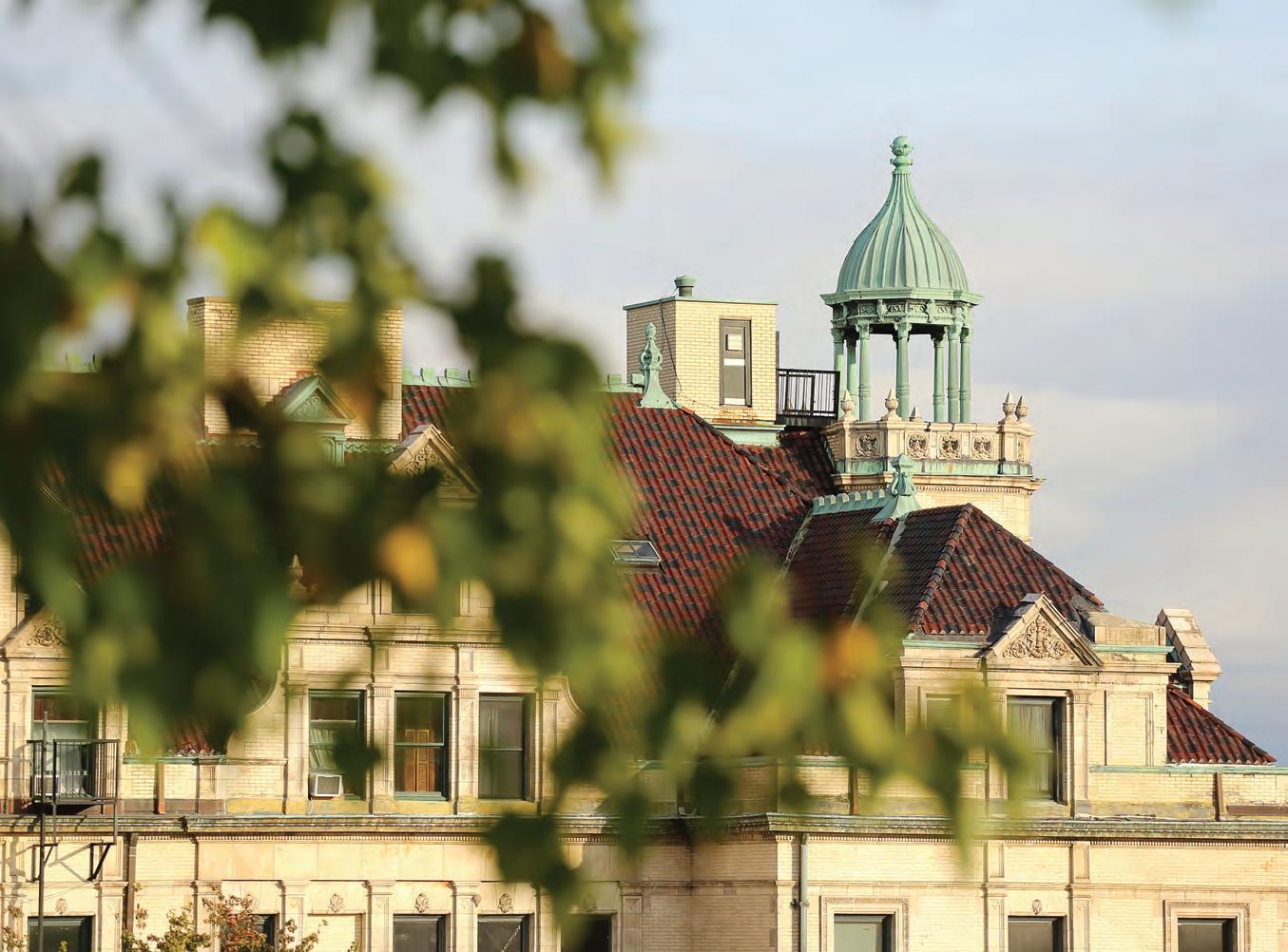Blazers Trail
Do not go where the path may lead, go instead where there is no path and leave a trail.





Do not go where the path may lead, go instead where there is no path and leave a trail.




Since its founding, The Masters School has been committed to educating students to make a positive difference in the world. Guided by a mission to be a power for good, many early Dobbs alumnae forged new paths in aviation, journalism, government and education. The baton has been passed through the generations and now, more than 145 years later, Masters graduates and students continue to build on the legacies of their fellow alums.
The Masters trailblazers featured in this issue of The Bulletin share not only a pioneering spirit but a common goal. Each followed their passion...striving to make a difference. none of them set out in order to blaze trails — they set out to do what they needed to do.
and is wowing audiences with his mix of styles, genres and influences, all stemming from the deep joy he experiences in creating music for others. All of the former Masters students we feature in this issue have worked hard because they were inspired to follow their hearts.
We are excited to share these and other stories of our alums who are simultaneously enriching our experience of the world and helping to change it for the better.
The Masters trailblazers featured in this issue of The Bulletin share not only a pioneering spirit but a common goal. They followed their passion — whether it was music, film, politics or law — striving to make a difference. None of them set out in order to blaze trails — they set out to do what they needed to do. Michele Roberts ’73, the first female leader of a major sports players union, tells us she didn’t spend a lot of time thinking about how it felt to break the glass ceiling. To her, it was more important that she wasn’t the last one to do so. Betsy Gotbaum ’56, whose career in public service spanned some 40 years, was the first female commissioner of the New York City Department of Parks and Recreation. She feels her greatest accomplishment was doing things that she thought would best elevate the quality of life in New York City. Musician Julius Rodriguez ’16 has — at age 24 — already earned a reputation as a rising jazz phenom
Our School’s mission challenges us to learn, to strive, to dare, to do — to be a power for good in the world. That power begins here. It begins in our hearts. It begins with inspiration.
With gratitude,
 Danforth Head of School
Danforth Head of School
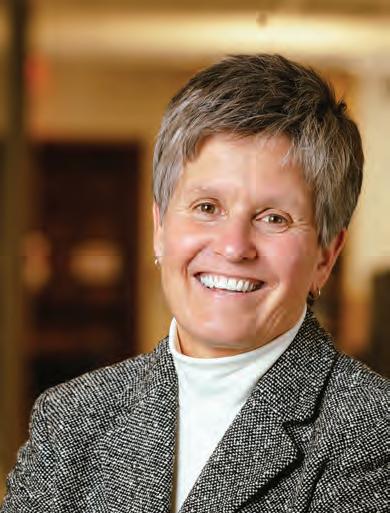
I wanted to send a note of appreciation for the spring Bulletin. I really enjoyed reading about the fencing program past and present. I believe I may have been a part of the first crew of fencers (about five or six of us) with Francisco Martin while I was a student there between 1983-1986. I was amazed to learn that not only is there an upper school team but a middle school team as well with over 100 fencers.
I also enjoyed the article about Sam Coffey ʼ17. I currently live in Portland, Oregon, and I am a huge fan of our women’s soccer team, the Portland Thorns. I had no idea she was a fellow Masters graduate!
 Erika Van Patten ‘86
Erika Van Patten ‘86
Our School's mission challenges us to learn, to strive, to dare, to do — to be a power for good in the world. That power begins here. It begins in our hearts. It begins with inspiration. ”
“
In an era when young women’s academies were mostly concerned with “finishing” their graduates to assume a role in society as wives and hostesses, Masters unapologetically sought to lay “broad and deep foundations for the building of character,” as expressed by school founder Eliza Bailey Masters. Accomplishments and action mattered. There has always been a throughline connecting the School’s “high ideals” and its motto, “Do it with thy might.”
As Eliza Bailey Masters’ great-nephew, Edgar Masters, a life trustee, noted, “Eliza, in her writings and teachings, comes down to us as loving and caring, but also as a stern and formal figure with strong religious beliefs, as befit a Presbyterian minister’s daughter. But as a family member, I like to speculate that underneath the Victorian demeanor was a bold risk-taker and a bit of a buccaneer.”
Clearly, generations of Masters students have taken to heart Eliza Bailey Masters’ exhortation, “The only thing you take with you when you die, girls, is your character; the only thing you leave behind is your influence.“
Whether in the skies, the halls of Congress, or on the battlefields of World War II, these three early trailblazers continue to inspire and make an impact today.
Long before anyone spoke about glass ceilings, Ruth Hanna McCormick Simms broke through many of them. She was the first woman to run a presidential campaign, as one of two managers for Thomas Edmund Dewey’s run.
Politics was in her DNA. As the daughter of Mark Hanna, a Republican senator from Illinois known as a political kingmaker, McCormick Simms was comfortable in a political milieu. Long active in progressive politics (with her first husband, Joseph Medill McCormick, a member of the prominent Chicago newspaper family, she pursued progressive activism), McCormick Simms was deeply involved in public life.
She was elected to Congress as a Republican from Illinois in 1928. Earlier, she had lobbied the Illinois legislature to give women the vote. From 1913 to 1915, she led the Congressional Committee of the National American Woman Suffrage Association. By 1918, McCormick Simms was the first chairman of the women’s executive committee of the Republican National Committee.
McCormick Simms was engaged in the public sphere in other ways as well. She bought and ran three newspapers in Rockford, Illinois, and became a rancher in Colorado. McCormick Simms also founded the Sandia School for Girls in Albuquerque in 1934; her second husband, Albert G. Simms, had been a congressman from New Mexico. She returned to the national political arena with Dewey’s campaign.

Three pioneers who inspired and made an impact
Few would have predicted that Ruth Rowland Nichols would become a celebrated aviatrix, at least not based on her first flight.

As a graduation present from Masters, her father arranged for her to fly with World War I pilot Eddie Stinson. Apparently, Nichols was terrified by the upsidedown, loop-the-loop portion of the flight.
But Nichols was determined to conquer her fear — and the field of aviation. She pursued her path at full throttle, and ultimately flew 71 different kinds of aircraft.
As a Wellesley College undergraduate, Nichols, a New York City native, took flying lessons and after graduation passed the test for her pilot’s license.
And then the firsts, and other distinctive accomplishments, kept coming:
• First woman in the world to receive a hydroplane license
• Set the women’s world altitude record in March 1931, at 28,743 feet
• Set the women’s world speed record in April 1931
• Set the women’s distance record in October 1931, flying from Oakland, California, to Louisville, Kentucky (1,977 miles)
• Set a women’s transcontinental record, flying from New York to Los Angeles in 16 hours 59 minutes 30 seconds
• Co-pilot on the first nonstop flight from New York to Miami
• A founding member, along with Amelia Earhart, of the Ninety-Nines, an organization of licensed women pilots
• Co-pilot in the supersonic Air Force TF-102A Delta Dagger, at an altitude of 51,000 feet and 1,000 miles per hour, again setting a record, in 1958
There was more to flying than personal glory for Nichols. In 1940, she established Relief Wings, a flying ambulance service to provide rapid medical attention. Nichols was also part of the Civil Air Patrol during World War II and earned the rank of lieutenant colonel. She continued her humanitarian work after the war, particularly in missions for UNICEF.
Talk about bold. When Helen Kirkpatrick sought a position as a reporter with the Chicago Daily News, she was rebuffed by the paper’s owner, who bluntly informed her that “we don’t have women on the staff.” Undeterred, Kirkpatrick replied, “I can’t change my sex. But you can change your policy.”
Small wonder that Kirkpatrick was one of the few women to become a World War II foreign correspondent. On assignment for the Chicago Daily News, Kirkpatrick covered the U.S. Army in Algeria and the Mediterranean theater, as well as the invasion of Normandy, ultimately following the Free French Forces as the first war correspondent assigned to that group. She covered the London Blitz and was a witness to the liberation of Paris. Kirkpatrick even went to Hitler’s Bavarian mountain retreat, Berchtesgaden, as her last wartime assignment. When the war was over, Kirkpatrick covered the Nuremberg trials.
For her services as a war correspondent, Kirkpatrick received the Medal of Freedom, the French Legion of Honour and the Médaille de la Reconnaissance française.
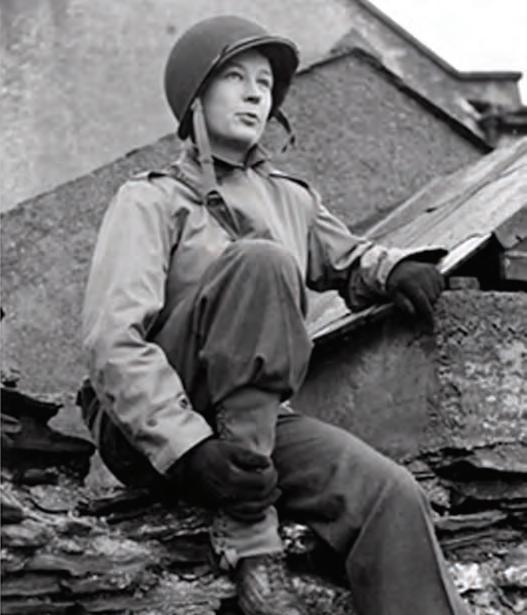
Her forthright stance was apparent when she and two other journalists launched a weekly newsletter that campaigned against an appeasement policy prior to World War II. When Kirkpatrick left journalism, she became the information officer for the Marshall Plan in Paris, then the public affairs officer for the State Department’s division of Western Europe.
Kirkpatrick, a Rochester, New York, native, graduated from Smith College and returned to Smith as the secretary to the president of the college as her final career posting.
Michele Roberts ’ 73 has a favorite expression:
“I either win or learn. I never lose.”
That attitude guided her through a lifetime of challenges, a career of firsts, and the frequent experience of being the only woman in the room, the only Black person, or often both. “The only way you can survive a storm is to get through it,” she says.

ABOVE PHOTO: Roberts poses with NBA players (left to right) Andre Iguodala, Jaylen Brown, Bismack Biyombo, Kyrie Irving, Chris Paul, Garrett Temple, Malcolm Brogdon, and CJ McCollum.

Roberts is best known for being the first female leader of any major sports players union. In 2014, she was appointed executive director of the National Basketball Players Association (NBPA). Profiles in The New York Times, The Washington Post, and Time quickly followed. Reporters often asked how it felt to “break the glass ceiling” — to which she responded that she didn’t spend a lot of time thinking about it. Being the first was nice. But it was more important to ensure that she wasn’t the last.
She had several formidable challenges ahead. The NBPA had recently weathered a
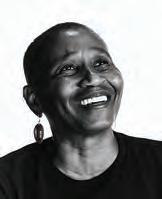
Jaylen Brown of the Boston Celtics talks with Roberts.
scandal: The union had fired its longtime leader. Players believed that they had gotten a raw deal with their latest collective bargaining agreement. Roberts’ role was not just to lead, but to rebuild. Although she had an impeccable reputation as a lawyer, she had no experience working in the worlds of sports or unions. But, no matter. Thriving in unfamiliar territory has always been her specialty.
Born in the South Bronx, Roberts grew up in the Melrose Houses, a low-income housing development. As a teenager, she was one of two Black students in her grade at Masters. Like other students of color, Roberts had a challenging time in the ’70s at the School. Her mother insisted she stay, and Roberts is glad she did. She says that if she had a daughter, she would send her to Masters, just like her mother did.
“The experience made me stronger,” says Roberts. “Life is not supposed to be comfortable all the time.”
From Masters, she went on to Wesleyan University and law school at UC Berkeley. She knew she wanted to be a public defender. Even before she started high school, Roberts had visited night court. She wanted to see where her brother’s friends were disappearing. Roberts remembered the public defenders and hearing about people who couldn’t afford a lawyer. After law school, she settled in Washington, D.C. After eight years, at just 31, she was already a star in her field. A Washington Post reporter profiled her, following her to a Saturday tae kwon do class and to court. Her past was always present in her public defender work. “People in the office tease me because, every now and then, I tell them that some client who I adore looks just like one of my brothers, just like one of my uncles,” she told the Post reporter.
When Roberts needed a new challenge, she transitioned to the world of corporate law,
working with two high-profile firms in the D.C. area. Then the opportunity arose at the NBPA. Again, she would be operating in a man’s world, working on behalf of NBA players and negotiating with a male-led league. As a finalist for the position, she confronted that reality head-on in a meeting with players before they elected their leader. She made it clear she was not intimidated. Any man who didn’t take her seriously — well that was to his detriment. She got the job.
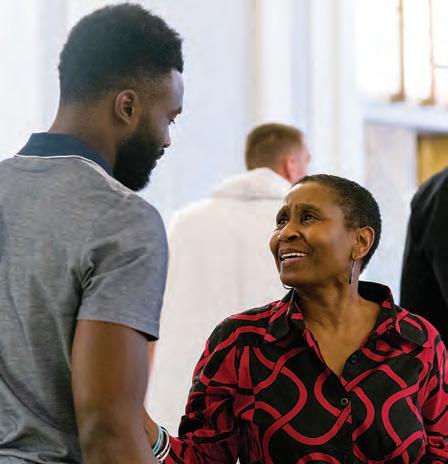
With the union’s credibility at a low, Roberts needed to reestablish trust and communication with the players — and she did. In her time, she renegotiated a new seven-year collective bargaining agreement with the NBA. It was widely heralded, with Sports Illustrated calling it “a win-win for both the league and the players.” She earned a reputation for being a selfless straight shooter among the union’s members. Roberts considers her greatest accomplishment passing a policy guaranteeing lifelong health care for anyone who played at least a threeyear contract with the NBA. Working as a professional athlete takes a toll on the body, and she had heard horror stories of former players’ medical problems. Once the policy took effect, Roberts received hundreds of letters from former players, their wives and their children, “just thanking the union because it made a difference.”
As she was getting ready to retire, the pandemic hit. The NBPA suspended its search for her successor in May 2020. Roberts helped negotiate the players’ return to play with the creation of the NBA bubble in Orlando. The operation allowed teams to finish the season in safe and controlled confines. Roberts moved into the bubble. She also led (though she says “followed”) the union during the players’ boycott of games as a Black Lives Matter protest in response to the police shooting of Jacob Blake in Wisconsin. The decision rippled across the world of
U.S. sports, inspiring the WNBA, Major League Baseball and Major League Soccer to cancel games. She knew her athletes were influential, but it was striking to witness their power in action. “It was so well exhibited that day,” she said. “We could stop sports.”
During her tenure, Roberts didn’t shy away from pointing out gender issues in the world of basketball. Throughout her professional life, she rarely encountered Black women in the positions she aspired to. She says her role models were her mother, who always pushed her to persevere through adversity, including attending Masters, and New York Representative Shirley Chisholm. She marveled at Chisholm’s courage to run for president, especially in the 1970s.
In interviews and directly to the commissioner of the NBA, Roberts remarked that few women had ascended to the league’s management ranks. She said it was “empowering” to speak that truth. Over time, she witnessed more women emerge as leaders in the industry. “All the women that I’ve worked with, both Black and white, frankly, have been vehemently committed to not going backward,” said Roberts. She can now say with certainty that she “wasn’t the last” woman to hold her role. Roberts retired in December 2021. Her successor, Tamika Tremaglio, is a Black woman.
Since her days as head of the drama club at Dobbs, Sally Kirkland ’59 has blazed a long trail through the entertainment industry.

Really long. Six decades long.
More than 270 acting credits long. And after landing roles in at least two more films coming out next year — the indie horror flick “Film Fiend” and Paramount’s “80 for Brady” starring Jane Fonda, Rita Moreno and Tom Brady as himself — this high-octane octogenarian shows no signs of slowing down.
RIGHT: Kirkland appeared in many theatrical productions during her time at Masters and was often cast in leading roles.
“Right on,” Kirkland exclaimed during a recent phone interview. “I’m very proud of the fact that for 62 years, I’ve been able to financially support myself working in film, TV and theater without ever having to go outside of the industry. I’ve been an independent woman all my life and never had to rely on a man or anyone else to support me. Dobbs prepared me to have the strength and courage, if you will, to just go for it myself without depending on anybody. And it worked out!”

Kirkland also cites her mother and namesake, Sally Kirkland, a longtime fashion editor at Vogue and Life magazines, as a powerful influence.
“Because she was a trailblazer, I inherited that from her,” Kirkland said. Her mother’s many accomplishments included hiring documentary photojournalist Gordon Parks to shoot fashion features for Life in 1948. “She was directly responsible for making him the first Black staff photographer at that magazine.”
Growing up surrounded by artists, designers, photographers and models inspired Kirkland to study visual and performing arts in school. “My mother was very supportive, and I was grateful that Dobbs gave me a platform to focus on my artistic pursuits.”
An active participant in the School’s drama program, Kirkland was often cast in leading roles — although not necessarily leading lady roles.
“The School was all girls when I was there and, being 5’9”, I played men a lot,” she said. “Playing all those men helped me lower my vocal register and really learn to project. It also helped prepare me so that when I was out in the world being an actress, I wasn’t in any way timid.”
“I remember The New York Times called me and said, ‘Miss Kirkland, you’ve been doing all this Shakespeare with Joseph Papp in the New York Shakespeare Festival, why are you suddenly taking off your clothes?’ and I said something like, ‘Well, I’m opposed to the Vietnam War and you can’t carry a gun on a naked body.’ It was all very political at that time,” she said.
Kirkland’s interest in politics can be traced back to her time at Dobbs, specifically her history teacher Nancy Maginnes Kissinger ’51.
“Miss Maginnes was my favorite, she was my hero,” Kirkland said. “She was very youthful and I really identified with her. And when she got married to Henry Kissinger, I got to say ‘Oh my God, that’s my history teacher!’ She was brilliant and really lit a fire under me.”
It’s a wonderful coincidence then that Kirkland’s Oscarnominated and Golden Globe-winning role for Best Actress in the 1987 film “Anna” had a historical and political bent. The title character played by Kirkland is a refugee who fled Czechoslovakia after the Communist takeover to start a new life in the U.S. The LA Times called Kirkland’s work “a blazing comet of a performance” in a film about “the irreconcilable pangs of exile.” In her acceptance speech, Kirkland made an impassioned plea for world peace.
“Winning the Golden Globe I would say is the highlight of my life, along with getting my ‘soul initiation’ in my church,” said Kirkland, who is an ordained minister in the Church of the Movement of Spiritual Inner Awareness. “Those two things have been my favorite two moments.”
After graduating from Dobbs, Kirkland continued her work as a stage actress performing mostly in off-Broadway productions. Forgoing four-year college, she joined The Actors Studio at age 20 and trained with legendary acting teacher Lee Strasberg. In 1968, Kirkland made headlines when she appeared naked on stage for most of Terrence McNally’s one-act play, “Sweet Eros.” In his review of the show, The New York Times theater critic Clive Barnes wrote, “For Sally Kirkland, playing the heroine, I feel nothing but admiration.” Barnes called her performance a “courageous piece of acting.”
The multihyphenate Kirkland is an accomplished visual artist who has held several gallery shows. “I’m really proud of my art,” she said. And she’s also an acting coach.
“Although I never had children of my own, I have taught over 2,000 young people in a 35-year period,” Kirkland said. “When I was at Dobbs, by being the head of the drama club, the head of the art club, and a top athlete in class, I had a chance to use my leadership skills. And from graduation until now, it gave me a really, really strong foundation.”
...I was grateful that Dobbs gave me a platform to focus on my artistic pursuits. ”
“
Early in her career, filmmaker Nia DaCosta ’07 made history by becoming the first Black woman director to debut a No. 1 film at the U.S. box office.

Nia DaCosta’s path to Hollywood started at 49 Clinton Avenue. “I took my first film class at Masters with Mr. Sugarmann,” she remembers fondly. “It really solidified my love for cinema and convinced me that I wanted to go to film school.”
Jesse Sugarmann was DaCosta’s film teacher and dorm parent at Masters. Currently a professor of new media at California State University Bakersfield, Sugarmann said that Nia was “a vibrant and catalytic community member who brought a keen energy, a deep generosity and an evolved sense of humor to creative projects on campus.” He recalled that “the Class of 2007 was an incredible group of young people, many of whom have already established outstanding careers at their young ages. The Masters School, particularly within the arts and theater, was an intense creative incubator at that moment. Nia was a big part of that exchange.”
After attending New York University’s Tisch School of the Arts and working as a production assistant, DaCosta made her feature film writing and directorial debut in 2019 with “Little Woods,” starring Tessa Thompson and Lily James. The critically acclaimed crime thriller won the Nora Ephron Prize for excellence in storytelling by a female writer or director at the Tribeca Film Festival.
“Candyman,” a socially conscious horror film and sequel to the 1992 film of the same name, came next. The film, which DaCosta directed and co-wrote with Academy Award-winner Jordan Peele, opened in August 2021 and broke box office records when she became the first Black woman director to have a film debut at No. 1, earning more than $22 million in its opening weekend.
Riding on the success of “Candyman,” DaCosta, a self-proclaimed comic book nerd, was tapped to direct “The Marvels,” the highly anticipated sequel to the blockbuster “Captain Marvel,” starring Brie Larson, Iman Vellani and Teyonah Parris. This cemented another first for DaCosta: the first Black woman to direct a Marvel Studios movie.
“I definitely didn’t set out to blaze any trails,” said DaCosta. “I think I’m walking the paths that have been created by so many amazing Black and women filmmakers before me.”
She cited the work of Black directors Kasi Lemmons and Gina Prince-Bythewood as having an impact on her at a young age, as did the films of Francis Ford Coppola and Paul Thomas Anderson.

“Now, I am so inspired by the work of filmmakers like Janicza Bravo, who make interesting, dynamic and idiosyncratic work,” she added.
DaCosta credits Masters with playing a big role in her becoming a cinephile.
“In boarding school before the age of Netflix, you’re stuck with whatever DVDs and VHS tapes are in the Common Room,” she recalls. “I was lucky that I had ‘Apocalypse Now,’ which started my love affair with Coppola, and ‘The Host,’ which is how I was introduced to Bong Joon Ho, now one of my favorite filmmakers.”
LEFT: daCosta (right) directs actor yahya Abdul-Mateen II on the “Candyman” set.
In the classroom, upper school English teacher Darren Wood witnessed DaCosta’s passion for storytelling and her natural ability to lead. “She was very clear about her purpose,” he said. “I’m very glad that she’s been able to do what she hoped she would.”
For those Masters students who are interested in pursuing a career in film, DaCosta, who continues to add milestones to her CV, offers this advice: “Do the work that brings you joy because you’ll never be happy, no matter how successful you are, unless the work is enough and is what fulfills you.”
I definitely didn ’ t set out to blaze any trails. I think I'm walking the paths that have been created by so many amazing Black and women filmmakers before me.
World-renowned conductor Marin Alsop ’73 knows a thing or two about being first. She made headlines and history when she became the first woman to lead a major American orchestra in 2007.
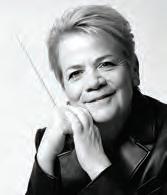
As the music director of the Baltimore Symphony Orchestra, a position she held for 14 years, she was living out her childhood dream and credits her alma mater with providing the hammer to shatter that glass ceiling.
“If I could attribute one thing to changing the course of my life and inspiring me to become who I am, it was going to Masters,” Alsop said.
High praise from a pioneer on the podium who has had a career of many firsts, including the first woman to be the principal conductor in Britain (Bournemouth Symphony Orchestra) and Brazil (São Paulo Symphony Orchestra) and the first woman to be chief conductor in Austria (ORF Vienna Radio Symphony Orchestra). Alsop is also the first woman to conduct BBC’s Last Night of the Proms and the first conductor to receive a MacArthur Fellowship.
“I never set out to do that,” she said of her trailblazing milestones. “My goal was just to become a conductor and try to become the best conductor I could be.”
Born in New York City, Alsop was the only child of professional classical musicians. She
played piano at 2, and the violin at 5. At 7, she was accepted into Juilliard Pre-College for violin. Her “aha” moment came at the age of 9 when Alsop attended a New York Philharmonic concert led by legendary maestro Leonard Bernstein. “When Bernstein turned around to speak to the audience, sharing his passion and insight into the music, I absolutely knew that I had to become a conductor. And I never changed my mind — even for one moment,” said Alsop.
Thanks to Masters piano teacher Rosalie Marshall, Alsop’s mother, a professional cellist, learned about Masters and a new scholarship being offered at the School.
LEFT: In 1989, Alsop was awarded the leonard Bernstein Conducting Fellowship to the Tanglewood Music Center, where she studied with the legendary conductor.
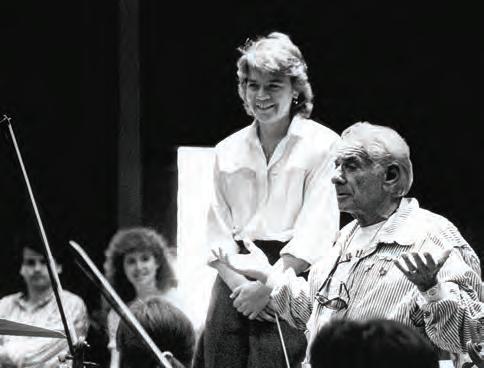
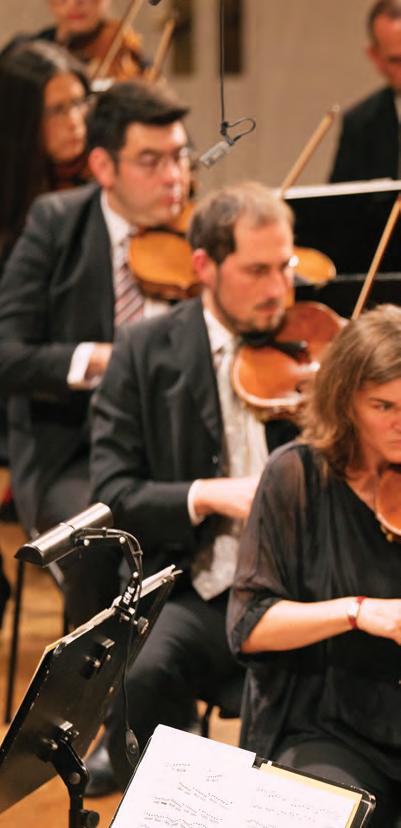
“Masters was a pretty elite place,” Alsop said. “It wouldn’t have been a place that my parents could have afforded or it wouldn’t have been a school on their radar at all. It sparked all of my creative and entrepreneurial energy that I naturally had but that had been clamped down by a very traditional education.”
Now an honorary trustee at the School, Alsop fondly remembers singing in the Glee Club and traveling to Europe for the first time with the group. She was a member of the Math Club and tried her hand at field hockey, lacrosse and basketball. She loved performing in language class plays directed by her Latin teacher Gertrude Link and French teacher
Currently, Alsop serves as the chief conductor of the ORF Vienna Radio Symphony Orchestra and the chief conductor and curator of the Ravinia Festival in Illinois. She became conductor of honour of Brazil’s São Paulo Symphony Orchestra and was named music director laureate of the Baltimore Symphony Orchestra. She is also the director of graduate conducting at the Johns Hopkins University’s Peabody Institute.
Julie Davidson. Her faculty favorite was Larry Hopkins, a math teacher who introduced her to the world of computer programming, circa 1969.
“The School was a place where all you had to do was say ‘I’m really interested in this’ and somebody would say ‘OK, let me help you.’ I had never experienced that before and so it opened up my thinking.”
After graduating from Masters, Alsop attended Yale University and transferred to The Juilliard School, where she received a Bachelor of Music in 1977 and a master’s degree in 1978, both in violin performance. She worked as a freelance musician with the New York Philharmonic, New York City Ballet and on Broadway. Around this time, she founded the all-female string swing band, String Fever. A few years later — with no conducting opportunities in sight — she launched and led her own ensemble, the Concordia Orchestra.
A turning point came in 1989 when she won the Koussevitzky Prize as outstanding student conductor at the Tanglewood Music Center, and met and studied with her mentor and hero, Leonard Bernstein.
She cites her parents and Bernstein as the biggest influences in her life.
“When I was a kid and I watched him, no matter where in the world something controversial or difficult was going on, he would pop up trying to use music as a vehicle to heal or to make a statement. And I really admired that in him,” she explained. “Whether I agreed with him or not, it didn’t matter. It’s the idea of standing up for what you believe and being counted and not being afraid.”
Bernstein’s message resonated with Alsop. Even with her early accomplishments, success in her profession eluded her. This was highlighted in “The Conductor,” the 2021 documentary about her life, which follows the obstacles she faced as a woman in a maledominated field. It also depicts the difficulties women conductors continue to face.
“I think the trick is to not get discouraged and not give up. Every crisis, every obstacle is really a moment for transformation and opportunity, which sounds a little Pollyanna, and of course it wasn’t like that all the time. It’s tough for me too, but I think there’s much more reward in living life that way.”
But her biggest satisfaction comes from mentoring others. In 2008, she started OrchKids, a Baltimore Symphony Orchestra music education program that is still going strong. The organization works with approximately 2,000 of Baltimore’s prekindergarten to 12th grade students providing musical instruction, instruments, academic support, healthy meals, mentorship and outside summer travel at no cost to students or families.
“These kids are doing fantastically well and many of them are at university now and stay in touch so it’s about building community,” Alsop said.
This year marked the 20th anniversary of the Taki Alsop Conducting Fellowship that she founded with her friend, Tomio Taki. Their mission is to mentor, support and promote talented women conductors at the beginning of their professional careers. As Masters made a difference in her life, she continues to do the same for others.
“Just watching these women in the fellowship succeed, I couldn’t be prouder if it were my own child. It’s just really fulfilling,” she said. “I hope that I can enable the next generation to move forward, not to just repeat the same pattern of events, especially for women. It’s really important that we progress, that we don’t just tread water. And so, the next generation, I hope, can move much further past where I was able to get to.”


Julius Rodriguez ̕16: A Jazz Prodigy Born to Play
RIGHT: At an early age, Rodriguez began practicing the drums at his home in White Plains, New york.

Rodriguez ’16 was, the story goes, wowing audiences at
Club in the West Village with Duke Ellington’s “Take the A Train” when he was 11 years old.
ABOVE: Rodriguez performed during Cautious Clay’s “Karma & Friends” tour at the Fine line in Minneapolis in February 2022.

“My dad was proactive with my musical studies,” said Rodriguez, “and when he learned that my teacher, the jazz pianist Jeremy Manasia, was hosting a jam session at Smalls at 1:00 a.m., he said ‘Let’s go and sit in and show him what you got.’”
His father accompanied him to New York jazz clubs, where Rodriguez would play with the grown-ups. “I was a pretty fearless kid,” he said. “Any show we would go to, I had no issues walking up to the stage and touching all the instruments.”
That was only the beginning for the gifted keyboardist and drummer, who before the age of 24 has made a name for himself performing alongside jazz greats including Wynton Marsalis, Roy Hargrove, Meshell Ndegeocello and Carmen Lundy. Rodriguez’s debut album, “Let Sound Tell All” on Verve Records, arrived last June to much fanfare.
As musician, producer, arranger and composer of “Let Sound Tell All,” he was true to himself. The album is filled with jazz, gospel, R&B, classical and hip-hop influences. “I tried to get away from categorizing what kind of music it is or playing different instruments on it,” Rodriguez said. “Some of it’s acoustic, some of it’s electronic, some of it’s love, some of it’s produced. No matter what it is, just take your time and listen to it and have your own experience with it and let the sound tell you what it is rather than trying to define it.”
At Masters, Rodriguez was a member of the School’s jazz band and credits Gilles Pugatch, upper school music teacher, with inspiring him during those years. “He found a way to challenge everyone, no matter what playing level you were,” said Rodriguez. “Everyone was able to contribute in a way that was meaningful to the performance and to themselves in terms of learning, which is really special.”
Pugatch kept Rodriguez on his musical toes with Great Gig in the Sky, one of the School’s premier showcases, where students collaborate to recreate a music album in its entirety through a live performance. He was thrilled to return as an alumnus to assist with the selection and arrangement of the 2021 performance of the Marvin Gaye album “What’s Going On?”
“It was awesome,” Rodriguez said. “I’ve done a lot of professional work in the music world and there’s nothing like that out here. There are no programs, colleges or anything that prepares you for real life, professional music situations, like Great Gig.”
“Julius was equally virtuosic in both piano and drums, something that is rare,” Pugatch said. “I used to refer to him as the humble prodigy. He was aware of his immense talent, but he never, ever let that intimidate others from playing alongside him.”
After he graduated from Masters, Rodriguez attended The Juilliard School for two years. He left Juilliard to begin his performing career and tour with rapper A$AP Rocky and the band Onyx Collective. When he went professional at a young age, he relied on the guidance of his parents and mentors in his music circles.
“I look up to a lot of people and ask them lots of questions,” he said. “I do a lot of research and try to know what I’m getting into before getting into it. You can only be as prepared as you prepare yourself.”
A jazz phenom who was often the youngest person in the room wherever he performed, Rodriguez is blazing trails like those he calls real trailblazers: Ndegeocello, Thelonious Monk, Stevie Wonder. “I feel those three artists were so unapologetically themselves that they created a whole other category for themselves.”
If all goes according to plan, Alex Pall ‘03 and his music partner, Drew Taggart, will be the first musical artists to perform at the edge of space in 2024. The electronic and pop music DJ duo, The Chainsmokers, has partnered with space tourism company World View to perform in a pressurized capsule tethered to a stratospheric balloon some 20 miles above Earth.
“It's an incredible honor, one that I am not sure we are worthy of,” Pall said. “That said, we will gladly propel ourselves into space and take the risk and honors. Hopefully we can execute this and get it done.”
This year, The Chainsmokers are celebrating their 10th anniversary. Over the past decade the duo has earned five Top 10 Billboard hits, a Grammy award, two american Music awards and 10 Billboard Music awards.

as a kid, Pall said his dreams revolved around taking shots as a basketball player, not being catapulted into space as an astronaut. In fact, he has a fear of heights. Nonetheless, as huge science fiction fans and investors in space research and technology companies Varda space and spaceX, Pall and Taggart are ready for liftoff.
Pall, a Westchester County native and New York university alumnus, looks back on his days at Masters with gratitiude. “I have to give credit to everyone at Masters,” he said. “I believe I am the sum of all my parts and experiences. If I had to single out one person, I would likely say Mr. Ndambuki.” Jude Ndambuki is a former science and computer science teacher.
Pall revealed that their space setlist would probably include “all the usual classics.” Back on Earth, The Chainsmokers have been busy touring in support of their latest album, “so Far so Good,” and exploring new frontiers in music.
“I think we consider ourselves more disruptors than trailblazers,” Pall said. “We love to find amazing opportunities and be first, but more importantly is seeing opportunities and doing them right.”
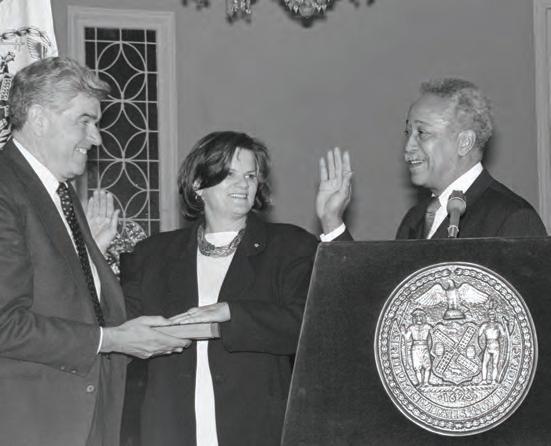

TOP PHOTO: Mayor david dinkins (right) presided over Gotbaum’s swearing-in ceremony. In attendance was her husband, Victor Gotbaum.
Photo courtesy of NyC Municipal Archives
ABOVE PHOTO: Gotbaum played on several sports teams while at Masters.

New York City’s first female commissioner of the Department of Parks and Recreation. The third woman elected to a citywide post — public advocate in her case — in New York City history. Advisor to three New York City mayors. President of the New-York Historical Society. All this from someone whose main objective when setting out on a career was “don’t be a secretary.”
Gotbaum’s earliest jobs were dictated by her first husband’s work. A member of the Dobbs Class of 1956, she earned a B.A. from George Washington University in 1961. In that era, she said, women of her ilk who hailed from educated, wealthy families used college to refine their pedigree and find a husband. Gotbaum was well on her way. A year earlier she married a man who worked for the CIA. Together, they moved to Recife, Brazil. While abroad, she learned Portuguese, taught English at the local American school, and had a baby. Like many CIA wives, she helped her husband with clerical work, only to learn she was “horrible” at it. When she divorced seven years later, Gotbaum returned to the U.S. to carve her own path.
By then, she knew she didn’t fit in with society’s expectations for women in her demographic. “I was supposed to get married, have this baby, and be happy and content for the rest of my life. And that just wasn’t me,” she said. After being offered only secretarial positions, Gotbaum finally got her break. She took a job working for the National Advisory Commission on Civil Disorders, known as the Kerner Commission. Established by President Lyndon Johnson, the commission produced a landmark report on racism and urban uprisings in 1967. Her work was the toehold she needed to launch what would become one of the most distinguished careers in the civic life of New York City in the last five decades.
Gotbaum’s first job in New York City was working for a program that hired and trained community members to be receptionists at local police precincts. It had the hallmarks of many roles she would come to assume: It connected her to people all over New York, required organizational acumen and noseto-the-grindstone work. In 1971, she became education assistant for Mayor John Lindsay. She continued her work in education with Mayor Abraham Beame, managing a training program for school security officers.
For most of the 1970s, Gotbaum juggled work and single motherhood. Her sisters helped care for her daughter, and her parents were resigned to her independence. Gotbaum says their attitude was: “Once again, there she goes.” In 1977, she married famed labor leader Victor Gotbaum, who was involved in major collective bargaining agreements with New York City during its fiscal crisis.
Gotbaum burnished her reputation as a hard-working go-getter, which propelled her into directorial roles. In the next stage of her career, she became known for her networking and fundraising skills and for invigorating nascent or struggling institutions. She worked with an array of populations essential to the health and vibrancy of city life.
Her first major leadership role was with the New York City Police Foundation, whose mission was to fortify their relationship with community members. In her seven years as executive director, she said, one of her greatest accomplishments was equipping every officer with a bulletproof vest.
Appointed New York City commissioner of the Department of Parks and Recreation, Gotbaum worked with Mayor David Dinkins to sign a 99-year lease with the United States Tennis Association to ensure that the U.S. Open remained in New York City. She relished the many facets of the job: the vast number of employees, the pile of tasks and responsibilities in every park, pool and beach — each a microcosm of its community.
“You’ve got to make sure that the grass is cut, the parks are clean,” she said. “You basically run a sanitation department within the parks.” She calls the role “the greatest job in New York City” — one that’s difficult but rewarding because “everybody loves parks.”
In 1994, she took over the New-York Historical Society, which was struggling financially. During her tenure, she brought in transformative gifts that restored the organization’s stability and led to its renaissance. In 2001, she was elected public advocate, serving as the ombudsman for the city, receiving civilian complaints and advocating for policy changes. She served two terms. Since 2018, she has been executive director of Citizens Union, a watchdog group that advocates for transparency and good government in New York City.
Reflecting on her days at Masters, Gotbaum recalls that she was popular and a good athlete. In light of these qualities, combined with her parents’ conservative politics, Gotbaum remembers her dorm’s house mother quipping in the yearbook that she would be “the wife of a Republican governor of Texas.” In that era, it was inconceivable that a woman might pursue a career in politics. She says that she was rebellious as a teenager, smoking and breaking various dorm rules. For a New York City girl — she’d grown up on the Upper East Side — it was difficult living with so many restrictions in quiet Dobbs Ferry, and school felt punitive.

Gotbaum’s work ethic has remained consistent throughout her life. She likes
to surround herself with smart people who aren’t ‘yes men,’ and who provide a new perspective. “I don’t want people around me who tell me what I want to hear. I want them to tell me what I don’t want to hear,” said Gotbaum. She’s proud to be known for taking an organization and “turning it around and making it important and viable for the city.”
Today, she’s still fundraising and still sending handwritten personal notes (though she jokes, “You get to the point where you think, I don’t know if I can do this anymore. My hand is killing me.”) Given her time as public advocate, she continues to hear questions such as, “What do I do about the sinkhole?” She welcomes them. “Those things, they’re important,” she says. “Somebody needs to be there to do them. And I would say that’s my greatest accomplishment: Doing the things I thought were good for the city.”
I don ’ t want people around me who tell me what I want to hear. I want them to tell me what I don ’ t want to hear.
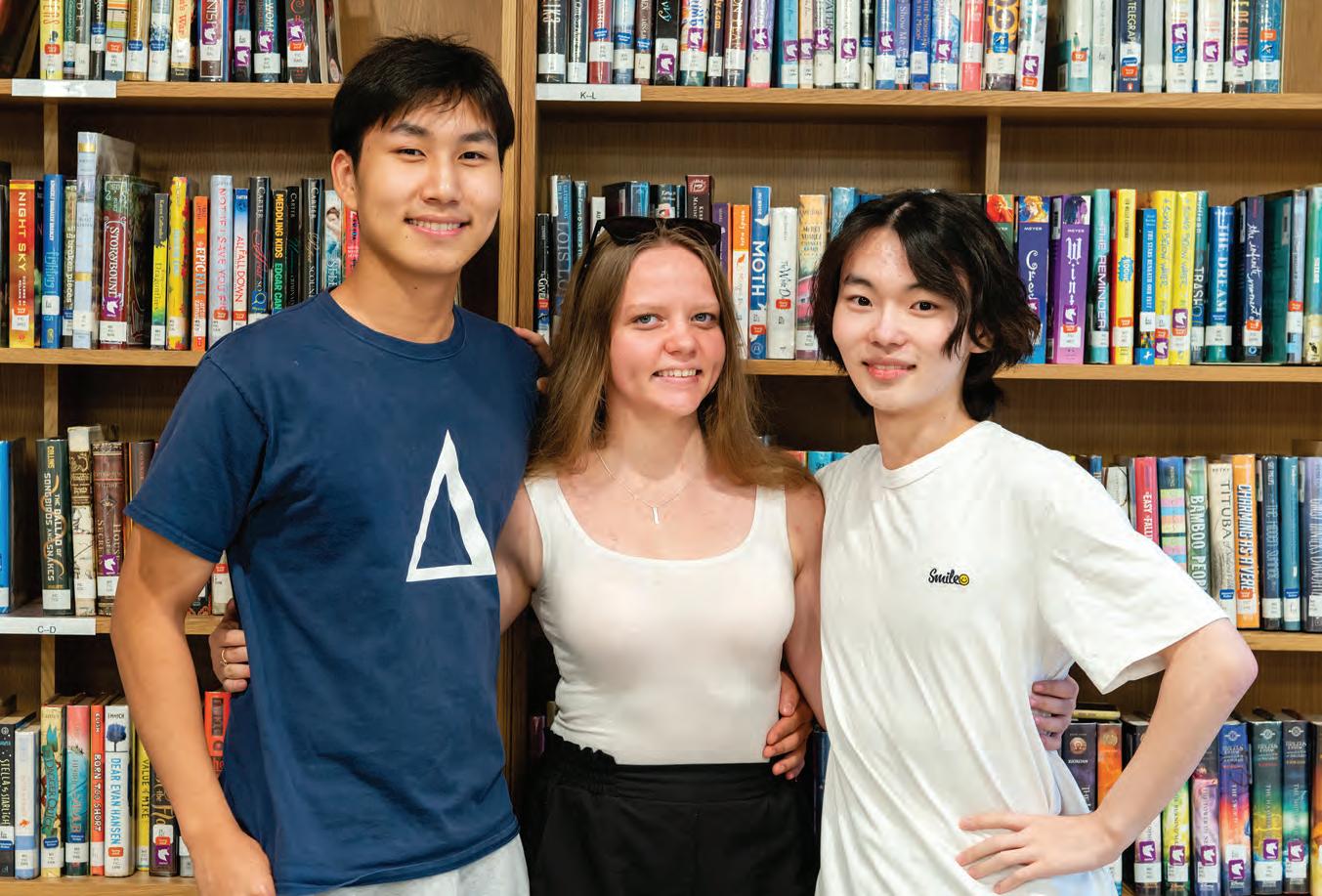
Emboldened by the School’s mission, three classmates make a powerful statement with Signisa, a resourceful app.

RIGHT: lee represented the Masters team at the T-Mobile headquarters in Bellevue, Washington, in July 2022.
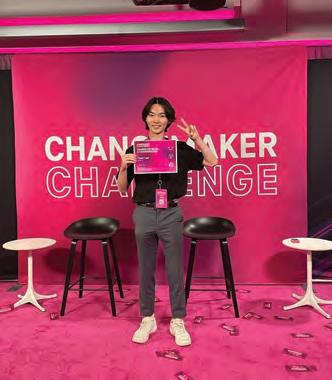
strengthened the bond among Nataliia Kulieshova ’23, Youri Lee ’23 and Dayan Battulga ’23. Together, the friends created Signisa, a sign language learning application, to help improve communication between the deaf and hearing communities. The app was a winner in the Equity in Action category in the prestigious 2022 Changemaker Challenge organized by T-Mobile.
Lee said they were inspired by the School’s mission statement that “emphasizes having a strong sense of responsibility and compassion in helping those around us.” It was a message he said the team carried with them and “with some research and a bit of personal inspiration, we decided to help the deaf community.”
The students’ advisor, John Chiodo, director of innovation, engineering and computer science, couldn’t be more proud. “When you consider that they competed against thousands of students in hundreds of teams from around the world, to be one of only five teams selected in their venture category is outstanding,” he said.
The trio was awarded $5,000 in seed money and an all-expenses-paid trip this past summer to the T-Mobile headquarters in Bellevue, Washington, for networking and mentorship opportunities. Lee represented the team in Bellevue. He enjoyed discussing projects with other student winners and gleaning advice from company executives.
“The acknowledgment we received has brought confidence in our mission and motivated us to run towards our vision,” Lee explained.
Kulieshova added, “It means that people believe in us and our idea, and that even the big tech giant T-Mobile sees our potential for success.”
Three years ago, Kulieshova met a young deaf person from her native Ukraine who expressed the hardships she faced when trying to communicate at hospitals or with the police, as well as the challenges of daily interaction
at stores and on mass transit. “Her story inspired me to make a change in my community, and I thought that my knowledge of computer science could be convenient here,” Kulieshova shared.
After enrolling at Masters, she realized the communication problem between hearing and deaf individuals was a global one. Kulieshova enlisted the help of classmates Lee, of South Korea, and Battulga, of Mongolia, for their business and programming skills. Signisa was soon born.

With the app, the three Masters students hope to increase sign language fluency through free, accessible courses that will incorporate hand detection through machine learning and computer vision technology to help users learn with ease.
The entrepreneurial seniors have dreams of expanding beyond the immediate goal of publishing the app. “We definitely see ourselves working on this after we graduate from Masters,” said Battulga. “We managed to communicate and hold meetings during the summer internationally, so I don’t think it will be hard to stay in touch with each other while we’re in college.”
The Masters School community celebrated the resilience, accomplishments and compassion of the 119 members of the Class of 2022 at an inspirational commencement ceremony on June 11.
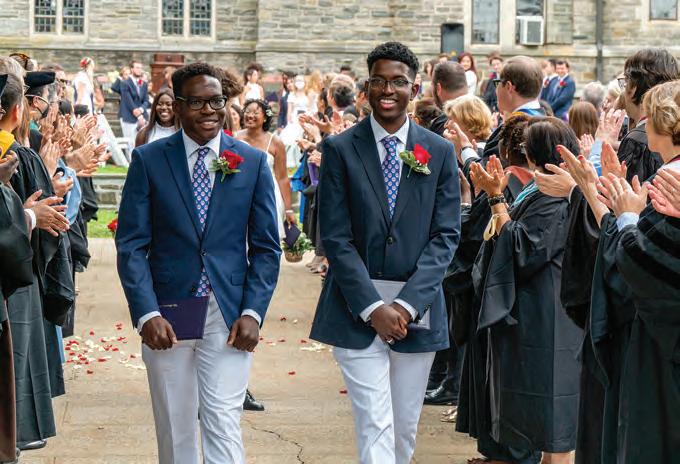

“It has brought us deep joy to share our path with you for the time that we have been here at Masters,” said head of School Laura Danforth. Acknowledging the complexity of the graduates’ high school experience, which was impacted by the COVID-19 pandemic, Danforth noted that “we have watched you support each other, encouraging your classmates when the struggle for perspective and stamina have felt all too real.”
“We are all so glad to have met you in this life,” Danforth added. “What a beautiful, and sometimes hard and complicated dance in the light it has been. Thank you for giving each of us a wonderful reason to come together, to enjoy this closing dance.”
When Class Co-President Kira ratan spoke to her classmates, she asked them to consider the concepts of yesterday, today and tomorrow. “It’s easy to talk about yesterdays and tomorrows when it’s all that surrounds us,” ratan said. “But we’re gathered together here today a celebration of a thousand yesterdays of hard work and the start of a million new tomorrows as we follow our dreams. Today, I urge us all to hold on to one another for as long as we can, because what we have here is rare.”
In a speech that touched on the many ups and downs of their senior year, ratan’s fellow class co-president, Denis sadrijaj, challenged his classmates: “Enjoy what you have now in this moment and in every moment thereafter. stay true to yourself, spend time with your loved ones, and enjoy life, because after all, that’s what the point of life is: to live.”
Washington Post White house Correspondent Tyler Pager, a 2013 graduate of Masters, delivered a humorous and poignant commencement address. he began with a list of all
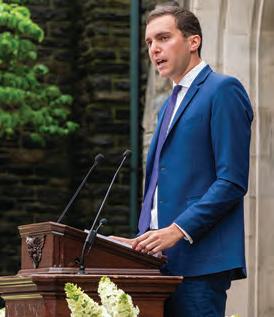
the failures and rejections he faced in high school and college.
“These moments of rejection are pivotal,” he said.
“Every rejection and I promise, there will be many big and small ones in your life marks a turning point. It can be a juncture where you give up. Or it could be the fuel to keep going.”
Pager also told the graduates the importance of pursuing their passions, using their voices for good, cultivating a strong work ethic (“It’s the one thing you can always control”), and being kind and compassionate to others.
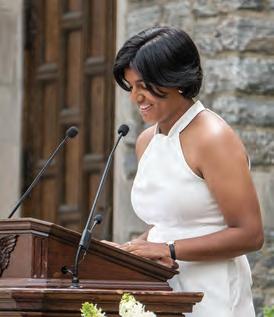
“Just as we all want others to extend grace to us at our lowest moments, I encourage you to do the same,” he said.
TOP: Kira Ratan, class co-president, addresses her classmates.
LEFT: Pager, a member of the Class of 2013, recalled his own graduation as he delivered this year’s commencement speech.
TOP: The Masters school Class of 2022
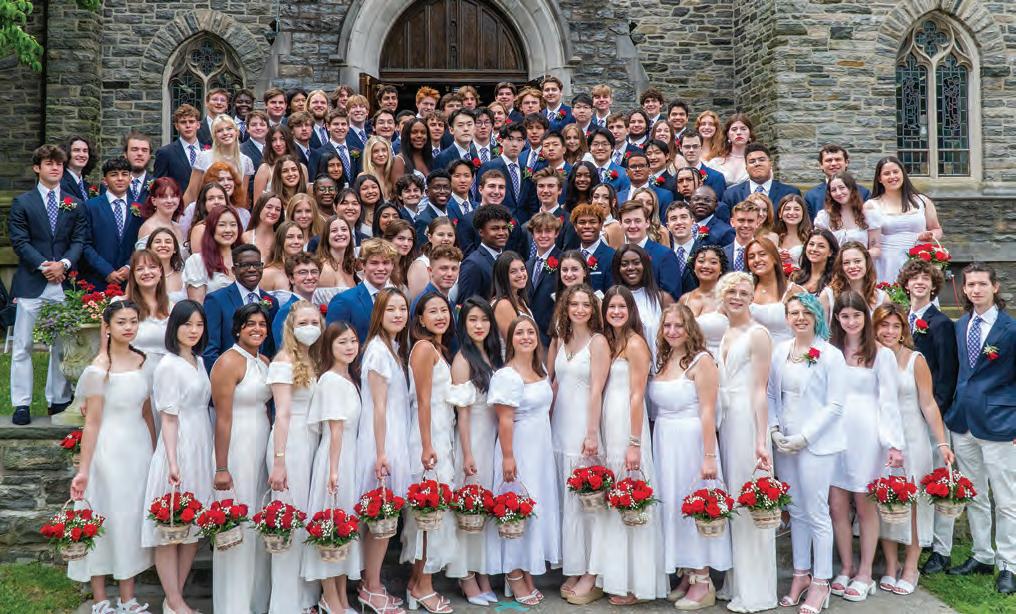
MIDDLE: denis sadrijaj, class co-president, recalled how many of his classmates spent a great deal of their childhoods at Masters and “have been forever changed by our experiences.”
ABOVE: It wouldn’t be a Masters graduation without the traditional rose petal toss.

sixty-two members of the Class of 2026 made the official transition to ninth grade in a joyful graduation ceremony held at the estherwood tent on June 10.



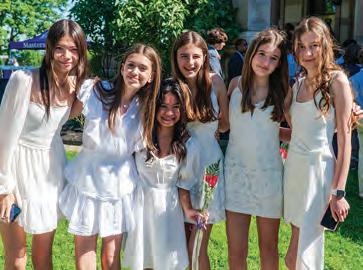
RIGHT: Christian Jinete’s mother provided a bit of levity for the occasion.
RIGHT: left to right: Jamie Milward, Alex Pinnock and Benjamin edelson enjoyed the festivities.
In less than a year, Masters’ new, three-story Innovation and Entrepreneurship Center (IEC) will open its doors to the Masters community.



The center’s workshops, classrooms and multi-use spaces will provide a dynamic learning environment where our students will hone their problem-solving skills by doing project-based work with peers, teachers and real-world entrepreneurs. students are eager to enroll in handson courses in entrepreneurship, engineering, product design, app creation and computer science in the new building. Programs will be available to students across both divisions.
LEFT: A triple-height atrium provides an inspiring central work hub that enables everyone to be part of the action. Conceptualized as a vertical Harkness space, the atrium will serve as an ideal venue for innovation.

Another great Founder's Day is in the books.
The battle between Delta and Phi continued to wage as the perennial tug of war pitted the teams against each other in a test of strength. at the end of the day, although Delta earned bragging rights as victors, the entire Masters community came together to revel in school spirit and honor the history and traditions of their school.


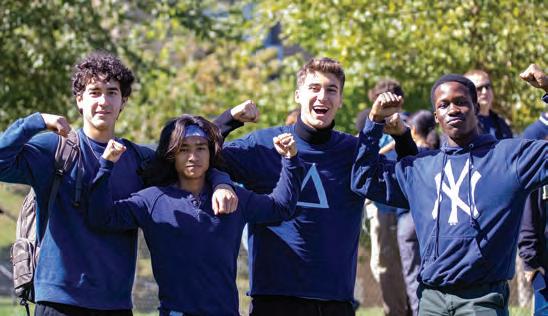
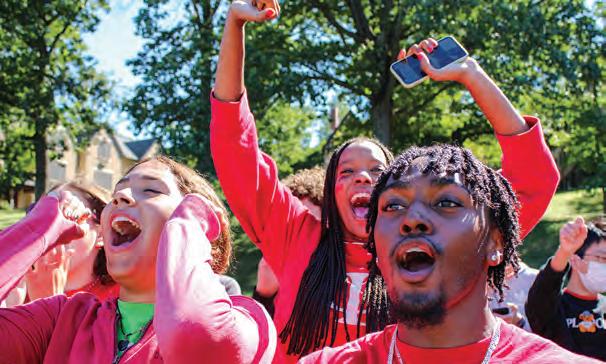
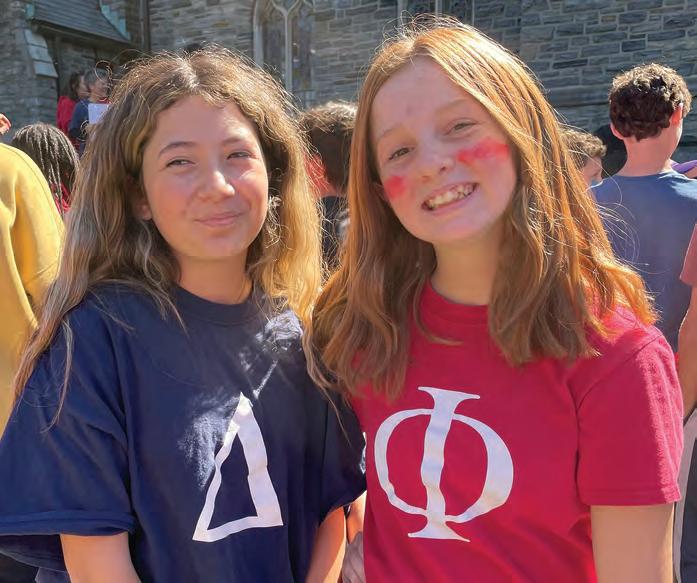



In
For nearly a century, two generations of matriarchs had graduated from the School, including Evan’s grandmother, Rosie Merrick Celentano ’39; his two great-aunts, Nellie Merrick Bissell ’33 and Marguerite Merrick Wick ’36; his mother, Barbara Celentano Leek ’68; his aunt, Ricky Celentano ’64, and his second cousin, Burma Bissell Bochner ’65.

“When we all go to our class reunions, it’s kind of like going to a family reunion too,” Evan said.
Growing up, it was Evan’s younger sister Amy Leek ’03, who seemed most likely to represent the third generation at Masters.
“As early as kindergarten I had heard about this amazing all-girls school where I might be able to go when I was older,” she said.
Then in the mid-’90s, the family learned about the School’s transition to coed, giving Evan the chance to apply.
“The switch to coed happened around the time I started looking at high schools,” Evan said. “When I was accepted at Masters, there was no question that I would enroll as a ninth grade boarding student. It was definitely the right choice for me and the right choice for my family. They were all so excited.”
Amy remembers being “thrilled” that Evan was going to Masters. “I thought he could pave the way for me if I got to go there, too.”
Evan’s mother and grandmother were equally delighted that Evan was now representing the family at their alma mater. Now they had a wonderful excuse to visit — often.
“During my first year, Grandma would come up a lot and take me out in New York City,” Evan said. “For her 50th birthday, my mom left West Palm Beach and rented a place in Manhattan for a month!”
Incorporating boys into the School was a gradual process, so Evan and his other trailblazing classmates were a bit outnumbered at first.
“The number of men was pretty sparse in the early years,” he said. “But it was fun — we were the ‘new boys.’ I remember at the Class of 1998 ceremony, there was a standing ovation for the first male graduate,” he said.
By the time Amy arrived at the start of Evan’s junior year, more boys had arrived and Evan was, in Amy’s words, a “big man on campus.” “It was so nice to have a big brother at school who already had a social network,“ she said.
“Evan really took me under his wing.”
And Evan liked having Amy at Masters, too. “We hadn’t been in school together since kindergarten so it was exciting we could both go to the same place,” he said.
They had very different interests: Evan participated in student government as junior and senior class president and played lacrosse; Amy was president of the student-directed ensemble Dohters and a leader of the School’s dance company. But they enjoyed spending time together while pursuing their separate passions.

“At Masters, we were able to find our footing, not necessarily the same footing,” said Evan, who currently works as a vice president of marketing for a software company, while Amy is a counseling psychologist. “That’s one of the strong points of the School.”
He also enjoyed feeling the presence of family members who had gone before him.
“I remember there was a plaque on the wall near where my religion class met,” Evan said. “It had the names of my grandmother and her two sisters. I always loved walking by and seeing that.”
In 2001, Evan graduated from Masters. He made history as the first grandson of an alumna to graduate from the School and took his place as the very first alumnus in the family, continuing a legacy and blazing a trail for future generations.
Evan Leek ’01 & Amy Leek ’03the fall of 1997, Evan Leek boldly went where no man in his family had gone before…to The Masters School!left to right: Barbara Celentano leek ’68, Amy leek ’03, evan leek ’01, and Burma Bissell Bochner ’65
The Masters School remains to this day one of the most positive and memorable experiences of my life. In 1971, fresh from acquiring a master’s degree in teaching, I went for my first job interview at Dobbs. The headmaster described the position of history teacher in a positive way. I accepted his offer and, thus, began my career in education. My colleague Lenore Laupheimer and I promptly changed Department of History to Department of Social Studies and we were off creating new courses. We established a History Hour once a week featuring speakers, slides and films rented from the local library.
My daughters, Debbie and Margie Schein, subsequently became members of the Classes of 1978 and 1981, respectively.
During the next two years, I became head of the department, honored with the Lightner Chair in History, and then director of college counseling. In 1981, I accepted a newly created position, senior associate director of admissions at Barnard College, where I learned about the role that colleges play in the admissions process.
In 1985 I established my own business of college counseling and tutoring. Over the years I traveled all over the country, attending
conferences and visiting colleges. I also had the privilege of working with international students throughout Europe. In those days, a girl sent me her essay from a boarding school in Switzerland, I graded it, and returned the essay — all through the mail. That took two weeks!
Presently, I’m on the editorial board of the Fiske Guide to Colleges.
Through it all I have kept in touch with students in my first U.S. history class — Norene Ginsburg Peck ’73, Leslye Lynford ’73 and Suzy Tipson Hall ’73 — and have attended concerts conducted by Marin Alsop ’73.
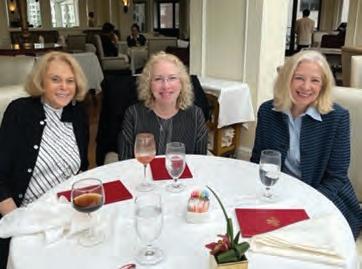
I have put the date on my calendar for their 50th reunion in May 2023.

Thank you, Dobbs (aka Masters), for helping me create a most satisfying career in teaching and mentoring young people all of my life.
Smith History Department (1996-2007)Following 36 years of teaching and administration at Cornell University; in Rome, Lugano, Riyadh, New Canaan, and Shanghai — all amazing educational situations — I was offered a new opportunity. At a dinner in Shanghai in 1996, Pam Clarke, head of The Masters School, suggested that upon my return home I speak with Colleen Roche, History Department chair. I followed up and realized that I found a new “academic home.” I found a school whose faculty prided itself in being a community that respected the diversity of each student, always striving to develop the total person.
Along with teaching, I enjoyed watching the students “do it with their might” in athletics, dance, drama and music presentations, and leadership in school life. Because of my academic work in China, I organized a teacher exchange program with a Chinese high school. Colleen, Maureen Fonseca and a number of our faculty had the opportunity to go to the Shanghai school, and our students benefited from the Chinese teachers visiting their classes.
The culmination of this exchange was an unbelievable trip in 2007, with Dobbs 16 performing at several schools and living with local families. For 10 days our group was treated like “rock stars.” When our bus pulled into one school, we were greeted by over 100 students, all clapping and cheering!
In retirement, my wife of 61 years, Agneta, who finished her 34 years of work as a reading specialist at New Canaan Country School, and I visited many countries. We skied in Zermatt and reminisced in St. Moritz, where we had spent great vacations with our young children. We hit the beaches in the Caribbean, traveled to Mill Valley, California, to visit our daughter and grandgirls and many times to Sweden, where our son and his family were living.
My passion for gardening provides an annual array of colors from June to October and, coupled with tennis, I hopefully stay in some semblance of “good shape.”
I must mention the “highlight” of my educational career. It started with a phone call in March 2009 from Dr. Fonseca telling me that the Class of 2009 asked me to be their graduation speaker. (As sophomores, their class was the final world history class I taught before retiring in 2007.)
My immediate answer: “Tell the class I would be most honored!”
One could not ask for a more “perfect ending.” Thank you, Masters!
JETSON LEDER-LUIS ’10 is an assistant professor at Boston university and a faculty research fellow at the National Bureau of Economic research. Dr. lederLuis is a scholar of public finance and publishes research on fraud in government expenditures. At BU, he teaches data analysis in Python and is the faculty advisor for the campus powerlifting club. he received his Ph.D. from MIT in economics in 2020.
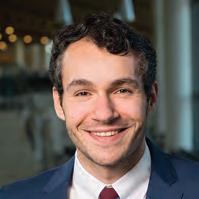 A N ALUMNUS AND A STUDENT — BOTH WITH A pASSION FOR ECONOMICS — ANSWER A SERIES OF q UESTIONS ON THEIR INTERE STS ACCOM p LISHMENTS AND p URSUITS
A N ALUMNUS AND A STUDENT — BOTH WITH A pASSION FOR ECONOMICS — ANSWER A SERIES OF q UESTIONS ON THEIR INTERE STS ACCOM p LISHMENTS AND p URSUITS
Why study economics?
JLL: Economics is a very broad field, and it can touch so many aspects of life. I think economics is a great field for people who are broadly interested and want to combine a variety of skills: mathematical ability, writing, critical thinking, visual presentation of data, computer programming. It is a common misconception that economics is just about finance, or just about money. Economists ask questions like: How does having kids affect your ability to get a job? How do policies incentivize or disincentive the adoption of new technology? Why and how do people vote? I have always been a broadly interested person, and economics allows me to indulge those interests. Our academics seminars are very exciting, sometimes contentious, and always feel relevant to the real world.
accept that economists are scientists who can contribute to policy decisions using a combination of theory and empirical analysis. I think this is part of a broader wave of anti-intellectualism over the past two decades, but also partly the fault of our own profession, where some very loud individuals have moved past the science and into activism. This is a debate within the economics profession as well. One big step forward in this direction has been the work of Josh Angrist, my graduate mentor and co-author, who was awarded the Nobel Prize last year for his work developing a toolkit for rigorous causal analysis. But we have to continue to engage the public with our work, be transparent and rigorous in our scientific methods, and keep our work dispassionate and apolitical.
"JESSE" XU ’ 23 is a co-founder and co-president of the Masters Economics Club. a boarding student from hong Kong, Xu says that economics is one of his passions. Xu also enjoys science research and running. he is the co-captain of the boys varsity cross-country and track and field teams.
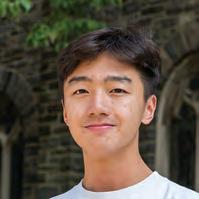
JX: Because it’s important and fun! Students nowadays wonder how to start their first investment, how to start up their own business, or how to make changes in social issues, and none of these can be easily executed without a solid understanding of economics. I see economics more like a “why things happened the way it did” kind of subject and it perfectly explains a lot of the historic events and contemporary problems. Students need more exposure to education in economics and more understanding of what economics is beyond investment, banking and business.
What’s the biggest challenge facing economists today?
JLL: Economists are grappling with a crisis in credibility. The public does not generally
JX: Coping with climate change and carbon pricing will definitely be big hurdles economists find themselves struggling with in the coming decades. As the damage of climate change and our carbon footprint get addressed more in international policy making, the majority of businesses will have to consider and adapt to more sustainable alternatives, and these changes will revolutionize many aspects of the global infrastructure and commercial production. In the following decades, as more countries and economies set up guidelines to approach carbon neutrality, economists will find themselves in the midst of a massive change in the economic landscape of the energy sector, and they must ask themselves some very difficult questions, such us how to make this transition cost effective and what are the implications of the cost on more underdeveloped area or underprivileged groups.
Was there a class or teacher at Masters that inspired your interest in economics?
JLL: My physics and statistics teachers at Masters — Chris Allen and Michele Dennis — were very influential to me. Both had gone to grad school and were exceptional educators. The road into academic economics is generally not to study economics in college, but instead to major in math. My time in AP Physics with Mr. Allen and AP Stats with Ms. Dennis honed my ability to do problem sets, to think critically, and to apply my math skills. My love of math led me to Caltech for undergrad, where I majored in applied math and eventually double-majored in economics.
JX: Mr. Young (Skeffington Young, upper school history teacher) has been an irreplaceable part of our economics club at Masters, which two of my peers and I started a year ago. I was very impressed with Mr. Young’s thought-provoking lectures and open-ended questions from my sophomore world history class. When I learned that he also taught a senior economics class, we reached out to him to be our club advisor. He always inspires me to think outside of the box about what economics was and what we could do in the club to bring together a group of kids interested in economics. I learned so much from him and I couldn’t have created the club without his support and feedback, as well the competitive opportunities that he pointed us to.
school group! Many of our members that year went on to be professional musicians. We had the opportunity to release two albums recorded in a professional studio in the city, sing at Radio City Music Hall, and tour in China. In retrospect, it was an incredible experience to have such world-class performing arts opportunities at 15.
JX: I’ve found a passion in running at Masters, so every day after school, my friends and I walk down to the track together. We always give it our all in every workout and we always have a great time wrapping up our school days with running.
What’s one journal article or book everyone should read?
JLL: I really enjoyed “Deep Work” by Cal Newport. It is not about economics; it is about how to manage your time and hone your ability to focus and work hard. Being a tenure-track assistant professor is very intense, and I live by my calendar. “Deep Work” is an important framing on how to focus. But it’s kind of like Buddhism — I aspire to do a better job of it but constantly fall off the wagon.
How can the field of economics be used as a power for good?
JLL: Economists have a monopoly on causal analysis with data. As data science and AI take off, it is important to remember that more data, and better algorithms, don't answer questions about cause and effect. Applied microeconomics teaches us how to examine these relationships, and it is very valuable for doing good in the world. We know so much more about effective government policy — such as health care policy, labor economics, and environmental regulation — because of these tools.
What is your fondest memory of Masters?
JLL: Singing with the Dobbs 16 on and off campus was one of the highlights of my experiences at Masters. We worked hard on our repertoire, rehearsing late into the evenings. We were really good for a high
JX: The Wall Street Journal is great! It keeps you updated on major events that teach you a lot about how the economics of things affect the world. It’s more focused on news related to businesses and economics than other sources. It’s easy to read, and it’s great for students.
JX: The field of economics is closely tied to the everyday life of every single person. The study of economics has always been the backbone of modern societies. Research in economics directly dictates the directions of domestic and international policies and decisions, and by studying the consequences of these policies, economists try to solve and optimize the problems that many of us face and see in the news every day. With more talents in the field of economics, problems that trouble us today such as recovery from COVID-19, controlling inflation, and managing wages can be better understood, and more suitable actions can be taken by the policymakers.
Ronen Israel is a co-founder of BioConvergent Health, a unique biotechnology platform that is developing a pipeline of innovative, convergent solutions initially in the areas of oncology and regenerative medicine.

He is also a senior advisor at AQR Capital Management. He was a principal, co-head of portfolio management, research, risk and trading and a member of the firm’s executive committee, retiring in 2021 after 22 years at the firm.
Israel received an Outstanding Article award as part of the 17th annual Bernstein Fabozzi/Jacobs Levy Awards from The Journal of Portfolio Management in 2015 and 2021, the Special Distinction Award as part of the Harry M. Markowitz Prize for the best paper published in the Journal of Investment Management in 2015 and 2021, and the Harry M. Markowitz Prize for the best paper published in the Journal of
Susan Katzke is a managing director at Credit Suisse in the equity research and multinational banks and brokers divisions, a role she has held since 2014. She worked at Credit Suisse as a managing director and a financial services sector head from 2000- 2009. From 2010-2014, Katzke was a financial services and equity research independent consultant and previously worked as an analyst at various firms, including Bear Stearns, Kidder Peabody, Montgomery Securities and Drexel Burnham Lambert.
A graduate of The Wharton School of the University of Pennsylvania with a B.S. in economics, Katzke earned an M.B.A. in general management from Harvard Business School. She is actively involved with Harvard Business School, currently serving as a consultant for its community partners and as an MBA and Young Alumni career coach from 2013-2015. Katzke served as a co-chair on the Board of Overseers at the Alzheimer’s Drug Discovery Foundation from 2013-2016. She and her husband, Michael, live in New York City with their son, Ethan ’24, and daughter, Hannah.
Investment Management in 2020. He has published papers in the Journal of Financial Economics, Journal of Portfolio Management, Journal of Investing, Journal of Investment Management, Journal of Alternative Investments and Financial Analysts Journal.
A member of the advisory board of the Center for Innovation & Precision Dentistry at the University of Pennsylvania, Israel is on the executive board of the University of Pennsylvania’s Jerome Fisher Program in Management and Technology. He is a member of the advisory board of The Rodney L. White Center for Financial Research, The Wharton School, University of Pennsylvania and an adjunct professor of finance at Yale University.
Israel earned a B.S. in economics from The Wharton School at the University of Pennsylvania, a B.A.S. in biomedical science from the University of Pennsylvania’s School of Engineering and Applied Science and an M.A. in mathematics, specializing in mathematical finance, from Columbia University.
Israel and his wife, Mindy, an active member of the Masters community, live in Purchase, New York, with their three children, Maddy ’23, Ariel and Abigail.
Stacey N. Lacy is managing director at Citi, where she is the Asia Pacific chief information officer and head of operations and technology, with teams spanning 14 countries across treasury and trade, securities and fund services, markets, wealth management and personal banking.
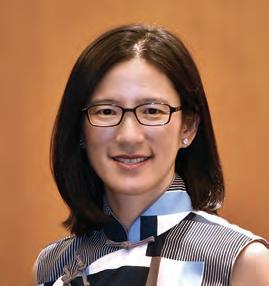
Lacy’s career at Citi spans 25 years, starting as a management associate in Hong Kong in 1996. Since that time, Lacy has spearheaded various leadership roles from operations management to project and program management, and leading the shared service centers for China, India, and Singapore.
Lacy, a passionate leader on talent, diversity and inclusion, was recognized as a Fellow at Singapore’s Institute of Banking & Finance in 2016. She holds Bachelor and Master of Arts degrees in economics from Boston University. Lacy and her partner, Ian, are proud parents of three children — Michael, Benjamin and Abigail.

Brooke Nalle is president of the Parent Association and an ex officio member of the Board. She has worked in education for more than 20 years. She began her career in education as a seventh grade humanities teacher at the Bank Street School for Children and then transitioned to private tutoring for middle and high school students. In 2009, she founded Sleepy on Hudson, a family sleep consultancy, helping children and their parents from all over the world get the rest they need. In 2021, Nalle sold Sleepy on Hudson and founded The Right Pond, a school placement consultancy.
Nalle graduated magna cum laude from Brown University in 1997 and has a master’s degree in early adolescent education from Bank Street School of Education. Nalle is a class officer for the Brown University Class of 1997.
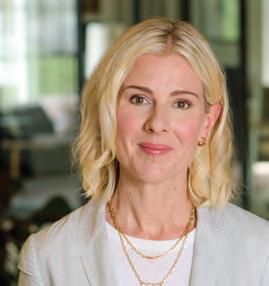
Nalle has served on the Executive Committee of the PA, as a Class of 2027 representative and as co-vice president for the Middle School. She also serves as an admission ambassador and mentor.
Nalle and her husband, Graham, live in Dobbs Ferry, New York, with their three children, Clara ’24, Loewy ’27 and Alistair.
William Roberts most recently served as a science teacher in the Upper School at Masters, teaching biology, human physiology, environmental science, and science and ethics in medical research. He also served on the investment committee for the School’s endowment and the committee to improve the faculty retirement plan. He enjoyed being assistant coach in the tennis program.
Prior to Masters, Roberts worked for more than 20 years in the biopharmaceutical industry at Merck and at Regeneron Pharmaceuticals. At Regeneron, he was vicepresident of regulatory development and medical safety with responsibility to lead the company’s interactions with regulatory authorities and the monitoring of the safety of its portfolio of drugs. Previously, Roberts practiced medicine as a gastroenterologist in Denver, Colorado.
Roberts graduated from Harvard College and the Columbia College of Physicians & Surgeons, completing an internal medicine residency and a gastroenterology fellowship at Columbia. An alumnus of Hackley School, he served on the school’s alumni board for 15 years, seven as president. He lives in Scarsdale, New York, with his wife, Cynthia, a former lawyer and current environmental advocate. They have two adult daughters.

Laura Danforth Head of School laura.danforth@mastersny.org
Meredith Halpern Associate Head of Strategic Communications
Isaac Cass Digital Communications Coordinator Christina Ha Communications Associate
Jen Schutten Associate Director of Communications
Design: KBWhite Communications LLC
Seth Marx
Associate Head for Institutional Advancement
Judy Donald Advancement Associate
Hilary Finkelstein Director of Annual Giving
Sydney Hummel Advancement Assistant
Sujata Jaggi ’01 Director of Alumnae/i Engagement
Carol Maxwell Individual Giving Officer
Maryann Perrotta Database Administrator
Mary Ryan ’00
Associate Director of Institutional Advancement
Amie Servino ’95, P’26 Director of Parent Engagement
h ea D o F sC hoo L Laura Danforth
B oar D o F T rus T ees
Edith C. Chapin ’83, Chair
Beth Nolan ’69, Vice Chair
Katherine A. Henry ’94, P’25, ’29, Treasurer
Dana W. Oliver P’22, ’25, Secretary Laura Danforth
Michael Greene P’10, ’13
Ronen Israel P’23
Christina Masters Jones Philip Kassen
Susan Katzke P’24
Stacey Lacy ’93
ZhiFeng Li P’22
Sydney Shafroth Macy ’70
Steve Marlowe P’23, ’23, ’25
Edgar M. Masters H’98, Life Trustee
Hannah Miller ’10
Allison Moore ’83, P’17, ’19, ’24
Susan Follett Morris ’57, Life Trustee
Brooke Nalle P’24, ’27
Hillary A. Peckham ’09
Rajiv Ratan P’22, ’24
Jonathan Resnick P’26, ’29
William Roberts
Steven Safyer P’04, ’07
Tracy Tang ’80, P’18
Mirna A. Valerio ’93
ho N orar Y T rus T ees
Marin Alsop ’73
Cynthia Ferris Evans ’52, P’76, ’86
Jeannette Sanford Fowlkes ’58, P’87
Ruth Mitchell Freeman ’51
Nancy Maginnes Kissinger ’51
Claudia Boettcher Merthan ’51
Lynn Pilzer Sobel ’71, P’99, ’05
D o BB s a L u MN ae / i
asso C ia T io N B oar D
Hannah Miller ’10, President
Ricardo Oelkers ’03, Vice President
Justina Michaels ’02, Clerk Natasha Bansgopaul ’04
Lucas Buyon ’11
Sharin Nechis Castillo ’84
Karen Feinberg Dorsey ’84
Austin O’Neill Dunyk ’98
Kathryn Taylor Harvill ’95
Jodi Innerfield ’05
Vincent Madera ’05
Pare NT asso C ia T io N e X e C u T i V e C o MM i TT ee
o fficers
Brooke Nalle P’24, ’27, President
Madeline Seguinot P’20, ’24 Co-Vice President, Upper School Monaqui Porter Young P’23, ’25, ’27 Co-Vice President, Upper School
Parke Anderson P’24, ’27, Co-Vice President, Middle School Midori Im P’22, ’28 Co-Vice President, Middle School
Committees and Chairs Saloni Singh P’27, Admission Support Chair
Brandi Maniscalco P’24, Boarding Parent Representative Nadia Reid-Christie P’23, ’25 Boarding Parent Representative Roxanne Todor P’21, ’23 Book Club Chair
Tracelyn Charles P’26, Co-Chair, Diversity, Equity and Inclusion Committee
Madeline Seguinot P’20, ’24 Co-Chair, Diversity, Equity and Inclusion Committee
Susie Williams P’26, Co-Chair, Diversity, Equity and Inclusion Committee
Andrew Barnes P’26, ’26, Masters Fund Parent Chair
Jordana Manzano P’23, ’26, Parent Program Committee Chair
C lass representatives
Parke Anderson P’24, ’27
Sara Barek P’27, ’29
Marielys Divanne P’24 Marla Evans P’24
Susan Furniss P’20, ’23, ’25
Midori Im P’22, ’28
Staci Marlowe P’23, ’23, ’25
Jenny Liang Milward P’24, ’26, ’29
Lori Moussapour P’15, ’25
Jennifer Nappo P’21, ’23, ’23
Jennifer Neren P’28
Joelle Resnick P’26, ’29
Shelly Steinwurtzel P’26, ’30
Latasha Thomas P’25, ’30
Paula Wood P‘26
Steven Yung P’23, ’30

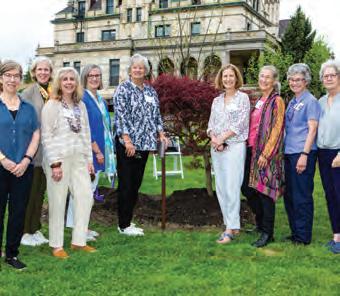




49 Clinton Avenue | Dobbs Ferry, NY 10522-2201
For generations, our community has come together in support of the
This annual initiative enriches the entire Masters experience, allowing each student to live the school's motto, do it with thy might, every time they step foot on campus.
To make your gift, visit mastersny.org/makeagift or contact Director of annual Giving hilary Finkelstein at 914-479-6510 hilary.finkelstein@mastersny.org
